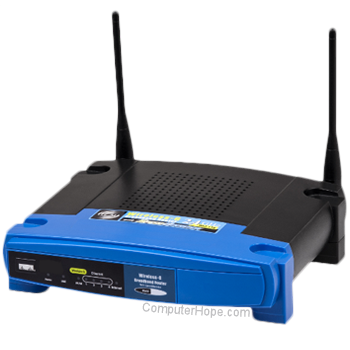How to access a home network router setup or console

This page is to provide home network user's a general resource on how to access their router setup or console so they may adjust the settings. Because of how many different routers there are available today, not all of the steps below may apply to you.
Try the most common IP router addresses. Click http://192.168.1.1, http://192.168.2.1, or http://10.0.0.1 to open a new window in your browser with the router setup. If these links do not work, follow the steps below.
Determine router address
Before being able to access a router, you must determine its IP address by following the steps below.
Microsoft Windows users
- Open the Windows command prompt.
- At the command prompt type: ipconfig and press Enter. See information displayed that is similar to the example below.
ipconfig
Ethernet adapter Ethernet: Connection-specific DNS Suffix . : computerhope.com. IP Address. . . . . . . . . . . . : 192.168.1.103 Subnet Mask . . . . . . . . . . . : 255.255.255.0 Default Gateway . . . . . . . . . : 192.168.1.1
- If you have multiple network adapters, make sure you are looking in the Ethernet adapter section. The Default Gateway address is the IP address of the router connected to your computer. In the example above, the IP address we want to remember is 192.168.1.1.
If you have multiple routers in your home or business, such as a cable and wireless router skip to the multiple router users section below.
Linux users
Linux users can follow the same steps listed above for Windows users. However, instead of using the ipconfig command in the console, you would want to use the ip command and view the information for inet. For example:
ip a | grep inet
inet 127.0.0.1/8 scope host lo inet6 ::1/128 scope host inet 192.168.1.17/24 brd 192.168.1.255 scope global dynamic eth0 inet6 fe77::ea9a:8fbf:fa17:74b7/64 scope link
Multiple routers
If you are using multiple routers in your network setup, make sure to find the IP address that corresponds to the router you want to access. If the router you're currently connected to is not found, try performing a traceroute.
To perform a traceroute using Microsoft Windows, type: tracert computerhope.com. If you are using Linux, type: traceroute computerhope.com. Either of these commands provide output similar to the example below.
traceroute computerhope.com
1 1 ms <1 ms <1 ms 192.168.1.1 2 <1 ms <1 ms <1 ms 192.168.2.1 3 * * * Request timed out. ... 14 31 ms 31 ms 30 ms unknown. Level3.net [64.158.69.18] 15 31 ms 29 ms 31 ms gi-3-14.dcr1.slc.xmission.net [166.70.5.66] 16 91 ms 203 ms 215 ms 404.gi-1-2.asr1.slc.xmission.net [166.70.5.73] 17 44 ms 29 ms 31 ms www.computerhope.com [204.228.150.3]
As seen in the above example, the first two hops are the internal routers. If we want to look at the router connected to the Internet the address, we would remember the address is 192.168.2.1.
Accessing the router
Once you have determined the IP address of the router you want to access, open an Internet browser window and in the address bar, type the IP address. So, if your IP address was 192.168.2.1 enter "192.168.2.1" in the address bar.
If accessible, you'll be prompted for a username and password. If you do not know this information, the username and password are likely set to default, which should be changed. The default information for your router is in the router documentation. Often, it is either "admin" or "administrator" for both the username and password or the username with no password.
After entering the proper username and password, you'll have full access to the router and be able to manage its settings.
Unable to access
If the router is not accessible using the steps above, try pinging the router IP address by typing: ping 192.168.1.1 (enter your router IP address if it's different) into the command prompt or console.
ping 192.168.1.1
PING 192.168.1.1 (192.168.1.1) 56(84) bytes of data. 64 bytes from 192.168.1.1: icmp_seq=1 ttl=64 time=10.5 ms 64 bytes from 192.168.1.1: icmp_seq=2 ttl=64 time=0.954 ms 64 bytes from 192.168.1.1: icmp_seq=3 ttl=64 time=0.885 ms 64 bytes from 192.168.1.1: icmp_seq=4 ttl=64 time=0.982 ms
If you do not get a response, check your network connections.
If you get a ping response back but cannot access the router through the above steps, your router settings are accessed differently. Alternatively, try telneting to the router.
